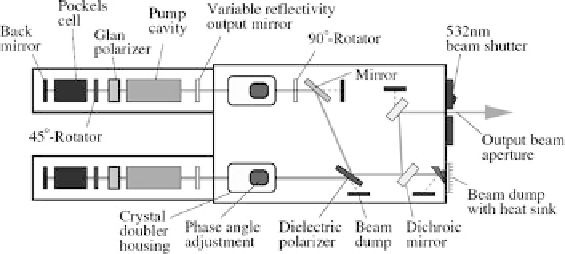Geoscience Reference
In-Depth Information
associated to double oscillators, which enables the user to adjust the separation
time between the two illuminations of the tracer particles independently of the
pulse strength (Fig.
7
).
The infrared laser is subjected to phase matching, to convert infrared 1,064 nm
to, generally, green light with 532 nm. The cooling system is an essential feature, as
this process requires stable temperatures. The laser beams from each cavity are then
conveyed to the output optics through a system of mirrors, reflectors, and shutters
(Fig.
8
). At the output optics, the laser beams are passed through prismatic lenses to
generate laser sheets.
Most cameras are either CCD (charged-couple device) or CMOS (complemen-
tary metal oxide semi-conductor). The former operate with photoelectric effect at
each pixel. Every pixel's charge is then transferred through the same output nodes,
which is reliable (not prone to noise) but slow. In the latter (CMOS), each pixel has
its own charge-to-voltage conversion node. It is thus highly sensitive and fast,
allowing for time resolving PIV (high temporal resolution). However, CMOS
cameras tend to be prone to noise.
The flow must be uniformly seeded with particles which, ideally, should have
densities close to that of the water and diameters appropriate to the zoom level
associated to the required level of detail. Conifer pollen particles have the density of
the water but will eventually cause fungi infestations in the flume. Synthetic
particles as the polyamide seen in Fig.
9
have been successfully used in water
flows even if their density is larger than that of the water.
The motion of the seeding particles in a viscous fluid is affected primarily by
their shape, size, and relative density, given a set of body and surface forces (e.g.,
gravity, drag, and lift). In a turbulent flow, body forces are considered negligible,
given the small volume of the particles and the high values of inertial forces and
drag (Melling
1997
).
To evaluate the capacity of the particles of seeding to follow the flow and, hence,
determine the smallest turbulent eddies, the solution of Hjemfelt and Mockros
(
1996
), for the limit case
s
1 (Melling
1997
), is employed:
Fig. 8 Double cavity laser source and optics (From Raffel et al.
1998
)

